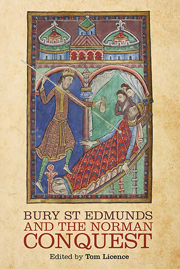Book contents
- Frontmatter
- Contents
- LIST OF ILLUSTRATIONS
- LIST OF MUSIC EXAMPLES
- LIST OF CONTRIBUTORS
- ACKNOWLEDGMENTS
- LIST OF ABBREVIATIONS
- Introduction
- 1 The Abbey and the Norman Conquest an Unusual Case?
- 2 Charters and Influences from Saint-Denis c. 1000–1070
- 3 The Abbey's Armoury of Charters
- 4 The Women of Bury St Edmunds
- 5 Baldwin's Church and the Effects of the Conquest
- 6 New Light on the Life and Work of Herman the Archdeacon
- 7 The Cult of St Edmund
- 8 St Edmund Between Liturgy and Hagiography
- 9 Books and their Use Across the Conquest
- 10 An Eleventh-Century Bury Medical Manuscript
- 11 Medicine at Bury in the Time of Abbot Baldwin
- 12 Medicine After Baldwin: The Evidence of BL, Royal 12. C. xxiv
- Index
2 - Charters and Influences from Saint-Denis c. 1000–1070
Published online by Cambridge University Press: 05 August 2014
- Frontmatter
- Contents
- LIST OF ILLUSTRATIONS
- LIST OF MUSIC EXAMPLES
- LIST OF CONTRIBUTORS
- ACKNOWLEDGMENTS
- LIST OF ABBREVIATIONS
- Introduction
- 1 The Abbey and the Norman Conquest an Unusual Case?
- 2 Charters and Influences from Saint-Denis c. 1000–1070
- 3 The Abbey's Armoury of Charters
- 4 The Women of Bury St Edmunds
- 5 Baldwin's Church and the Effects of the Conquest
- 6 New Light on the Life and Work of Herman the Archdeacon
- 7 The Cult of St Edmund
- 8 St Edmund Between Liturgy and Hagiography
- 9 Books and their Use Across the Conquest
- 10 An Eleventh-Century Bury Medical Manuscript
- 11 Medicine at Bury in the Time of Abbot Baldwin
- 12 Medicine After Baldwin: The Evidence of BL, Royal 12. C. xxiv
- Index
Summary
Introduction
In comparison with the large number of manuscripts at Saint-Denis from the Carolingian period and the twelfth century, the sources for the eleventh century, the time of Abbot Baldwin of Bury St Edmunds, are meagre. This is one indication that the abbey suffered severe losses in the tenth century at the hands of the Normans. It lost many of its domains, the fabric of the church seems to have deteriorated greatly, and the performance of the liturgy seems to have become lax.
Abbot Suger, writing in the 1140s, saw the division of the Carolingian empire under the sons of the son of Louis the Pious, that is, Charles the Bald, as the major reason for Saint-Denis's losses. In addition to the problem the monks faced in recovering their illustrious past, the monastery encountered two major challenges to its prestige in the first half of the eleventh century. First of all, the monks at Saint Emmeram, Regensburg, claimed that they had the relics of St Denis. In response to this, the saint's body was exhumed in 1053, and a new feast, the Detection of Saint Denis, was celebrated on 9 June to commemorate this event. Secondly, the bishop of Paris challenged Saint-Denis's claims of exemption from episcopal control. So it is perhaps not surprising that the extant manuscripts and charters from the eleventh century reflect both of these topics: charters were forged to prove the monastery's independence from episcopal control, and manuscripts were created for its new liturgical celebrations.
- Type
- Chapter
- Information
- Bury St Edmunds and the Norman Conquest , pp. 22 - 30Publisher: Boydell & BrewerPrint publication year: 2014



